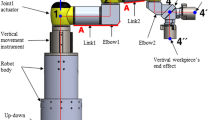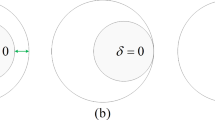Abstract
Automatic assembly using manipulators has lately attracted increased attention due to its low cost and high quality. Since a manipulator is entirely rigid, position or angle deviations often cause assembly failure or even cause damage to the manipulator. A series–parallel compliant device that did not produce a significant contact force was developed during this study to achieve reliable assembly when position or angle deviations occurred. The primary objective for this device was for it to be compliant enough to effectively counteract contact forces and move in a specific direction. The device allowed for a relatively significant misalignment during assembly, and it produced a small force, which protected parts and manipulators. It had two compliant components that were connected using a rigid block. Each compliant component consisted of a rigid frame, four elastic limbs with similar “n” shapes, and a square block. Because an elastic material was used, each elastic limb was equivalent to a compliant hinge (or spring), essentially making the device a series–parallel compliant structure. In this way, the device became compliant and could move in a particular direction when the contact force exceeded a specific value. On this basis, the desired compliance of the device was obtained in all directions depending on the compliant deformation, and an optimization method was proposed to determine the parameters of this device based on the kinematic model and a stiffness analysis. Experiments were performed at different working conditions, and their results demonstrate that this device performed reliably during assembly even when a position deviation or an angle deviation occurred.




















Similar content being viewed by others
References
Liu S, Xu D, D, P. Zhang, and Z. T. Zhang, (2016) High precision automatic assembly based on microscopic vision and force information. IEEE Trans Autom Sci Eng 13(1):382–393
Takahashi J, Fukukawa T, Fukuda T (2016) Passive alignment principle for robotic assembly between a ring and a shaft with extremely narrow clearance. IEEE/ASME Trans Mechatron 21:196–204
Ma X, Wu D, Gao Y (2018) An approach to countersink depth control in the drilling of thin-wall stacked structures with low stiffness. Int J Adv Manuf Technol 95:785–795
Vidrios-Serrano C, Mendoza M, Bonilla I (2021) A generalized vision-based stiffness controller for robot manipulators with bounded inputs. Int J Control Autom Syst 19:548–561
Peng J, Ding S, Yang Z (2020) Adaptive neural impedance control for electrically driven robotic systems based on a neuro-adaptive observer. Nonlinear Dyn 100:1359–1378
Lakshminarayanan S, Kana S, Mohan DM (2021) An adaptive framework for robotic polishing based on impedance control. Int J Adv Manuf Technol 112:401–417
Liu L, Leonhardt S, Ngo C, Misgeld BJE (2020) Impedance-controlled variable stiffness actuator for lower limb robot applications. IEEE Trans Autom Sci Eng 17:991–1004
Izadbakhsh A, Khorashadizadeh S, Ghandali S (2020) Robust adaptive impedance control of robot manipulators using Szász-Mirakyan operator as universal approximator. ISA Trans 106:1–11
Kumar N, Rani M (2021) Neural network-based hybrid force/position control of constrained reconfigurable manipulators. Neurocomputing 420:1–14
Zhang H, Li L, Zhao, (2021) The hybrid force/position anti-disturbance control strategy for robot abrasive belt grinding of aviation blade base on fuzzy PID control. Int J Adv Manuf Technol 114:3645–3656
Baspinar C (2020) Robust position/force control of constrained flexible joint robots with constraint uncertainties. J Intell Robot Syst 100:945–954
Peng F, Wen H, Zhang C, Xu B, Li J, Su H (2020) Adaptive robust force position control for flexible active prosthetic knee using gait trajectory. Appl Sci 10(8):2755
Peidró A, Tavakoli M (2019) Design of compact switchable magnetic grippers for the HyReCRo structure-climbing robot. Mechatronics 59:199–212
Xing D, Liu F, Liu S, Xu D (2019) Efficient insertion of partially flexible objects in precision assembly. IEEE Trans Autom Sci Eng 16:706–715
Rosati G, Minto S, Oscari F (2017) Design and construction of a variable aperture gripper for flexible automated assembly. Robot. Comput Integr Manuf 48:157–166
Chen H, Wang J, Zhang G (2009) High-precision assembly automation based on robot compliance. Int J Adv Manuf Technol 45:999
Sturges RH, Laowattana S Jr (1996) Design of an orthogonal compliance for polygonal peg insertion. ASME J Mech 118:106–114
Haskiya W, Qiao H, Knight JAG (1998) A passive compliant wrist for chamfer-less peg-in-hole assembly operation from vertical and horizontal directions. Proceedings of the Institute of Mechanical Engineers 212:473–478
Haskiya W, Maycock K, Knight J (1999) Robotic assembly: chamfer-less peg-hole assembly. Robotica 17:621–634
Callegari M, Palpacelli M, Principi M (2006) Dynamics modelling and control of the 3-RCC translational platform. Mechatronics 16:589–605
Kim HS, Dong IP, Chan HP (2016) Variable passive compliance device for robotic assembly. Journal of the Korean Society of Manufacturing Technology Engineers 25(6):517–521
Kronander K, Billard A (2016) Stability considerations for variable impedance control. IEEE Trans Rob 32(5):1298–1305
Liu S, Xing D, Li Y, Zhang J, Xu D (2019) Robust insertion control for precision assembly with passive compliance combining vision and force information. IEEE/ASME Trans Mechatron 24:1974–1985
Xing D, Liu X, Liu F, Xu D (2021) Efficient insertion strategy for precision assembly with uncertainties using a passive mechanism. IEEE Trans Ind Inform 17(2):1263–1273
Chen G, Zhang Z, Kong L, Wang H (2019) Analysis and validation of a flexible planar two degrees-of-freedom parallel manipulator with structural passive compliance. ASME.J. Mech Robot 12(1):011011
Rahman SMM, Wang Y (2018) Mutual trust-based subtask allocation for human–robot collaboration in flexible lightweight assembly in manufacturing. Mechatronics 54:94–109
Dai JS, Ding X (2006) Compliance analysis of a three-legged rigidly-connected platform device. ASME J Mech Des 128(4):55–764
Khavandi Khiavi A, Mohammadi H (2018) Multi-objective optimization in pavement management system using NSGA-II method. Journal of Transportation Engineering Part B Pavements 144(2):04018016
Funding
This work was partially supported by the National Key R & R&D Program of China (2018YFB1308202), National Natural Science Foundation of China (52075556), and the Key R&D Program of Hunan Province (2021SK2016), and the Science and Technology Innovation Program of Hunan Province (2020GK4097).
Author information
Authors and Affiliations
Contributions
Du Xu provided the design idea and conducted the experimental tests. Prof. Lu was a major contributor in writing the manuscript and provided valuable suggestions for the experiments and sorting of the whole article. All authors read and approved the final manuscript.
Corresponding author
Ethics declarations
Ethics approval
Not applicable.
Consent to participate
Not applicable.
Consent for publication
Not applicable.
Conflict of interest
The authors declare no competing interests.
Additional information
Publisher's note
Springer Nature remains neutral with regard to jurisdictional claims in published maps and institutional affiliations.
Rights and permissions
About this article
Cite this article
Xu, D., Lu, X. Design and modeling of a series–parallel compliant device for reliable assembly during a position or angle deviation. Int J Adv Manuf Technol 119, 6535–6547 (2022). https://doi.org/10.1007/s00170-021-08417-0
Received:
Accepted:
Published:
Issue Date:
DOI: https://doi.org/10.1007/s00170-021-08417-0




